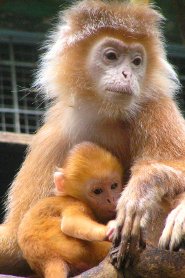 The Javan langur (Trachypithecus auratus) is a large monkey that sports a mane like a lion. They are also known as an Ebony letung or Javan letung. The adult Javan langur has long, black hair, which grows forward around the shiny black leather-like face giving it a unique look. The neck and chest are brownish colored. Some of the langurs are a reddish-gold in color even though black is the dominant color. The infant langurs are orange-red in color. Langurs weigh from 7.1-18.1 kg (15.7-40 lbs.). The Javan langur measures 44-65 cm (17.3-25.6 in) in length with a long prehensile tail of 61-98 cm (24-38.6in). The langur is diurnal and arboreal and rarely goes to the ground. However, when they do travel on the ground, they use all four limbs to walk. The Javan langur is found in Java, Bali, and Lombok, Indonesia. There are many different species of langurs that are found in India, Indonesia, and in Asia. The Javan langur resides in forested areas, mangroves, and fresh water swamps. These monkeys are herbivores and favorite foods include flower buds, flowers, ripe or unripe fruit, leaves, and occasionally insects and larvae. Researchers have also observed langurs living on teak plantations. All langurs have enlarged salivary glands along with an asacculated or chambered stomach to aid in the digestion of the cellulose plant material they consume.
The Javan langur (Trachypithecus auratus) is a large monkey that sports a mane like a lion. They are also known as an Ebony letung or Javan letung. The adult Javan langur has long, black hair, which grows forward around the shiny black leather-like face giving it a unique look. The neck and chest are brownish colored. Some of the langurs are a reddish-gold in color even though black is the dominant color. The infant langurs are orange-red in color. Langurs weigh from 7.1-18.1 kg (15.7-40 lbs.). The Javan langur measures 44-65 cm (17.3-25.6 in) in length with a long prehensile tail of 61-98 cm (24-38.6in). The langur is diurnal and arboreal and rarely goes to the ground. However, when they do travel on the ground, they use all four limbs to walk. The Javan langur is found in Java, Bali, and Lombok, Indonesia. There are many different species of langurs that are found in India, Indonesia, and in Asia. The Javan langur resides in forested areas, mangroves, and fresh water swamps. These monkeys are herbivores and favorite foods include flower buds, flowers, ripe or unripe fruit, leaves, and occasionally insects and larvae. Researchers have also observed langurs living on teak plantations. All langurs have enlarged salivary glands along with an asacculated or chambered stomach to aid in the digestion of the cellulose plant material they consume.The Javan langur is listed as "Vulnerable" on the IUCN Red List of Endangered Species. Humans are the only known predator at this time. Langurs are illegally hunted for food or captured alive for pets. The habitat of the Javan langurs is being destroyed by deforestation for human habitats, agriculture, and illegal logging. Fortunately, some of these adorable monkeys live on protected reserves.
Picture of the javan langur by Belgianchoclate, licensed under the Creative Commons Attribution 2.0 Generic license.
Keywords: black , tail , white , orange , yellow , diurnal
The Ebony leaf monkey, javan langur is listed as Endangered (EN), considered to be facing a very high risk of extinction in the wild, on the IUCN Red List of Threatened Species
Countries
Indonesia
Custom Search